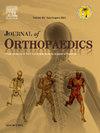风险分析指数作为老年肥胖患者择期全关节置换术30天死亡率的预测因子
IF 1.5
Q3 ORTHOPEDICS
引用次数: 0
摘要
美国老年人口持续增加,导致退行性关节疾病的发病率上升。结合肥胖在美国的高患病率,骨科医生在高风险患者中进行的选择性全关节置换术(TJA)手术数量创历史新高。由于年龄和肥胖是TJA术后死亡的危险因素,术前风险分层工具(如虚弱)可用于优化手术候选人选择,以减轻不良后果。方法查询美国外科医师学会国家手术质量改进计划数据库中年龄≥65岁、BMI≥30 kg/m2、因退行性关节疾病行选择性原发性全膝关节或全髋关节置换术的患者。脆弱性采用5项修正脆弱性指数(mFI-5)和风险分析指数(RAI)进行测量。采用多变量回归评估脆弱度的预测值,并采用受试者工作特征(ROC)分析量化鉴别准确度。结果2015 - 2019年共有169065例患者符合纳入标准。中位年龄为71岁,60.8%为女性,72.6%为白人。根据RAI和mFI-5测量,虚弱程度的增加预示着更高的死亡率。此外,当使用ROC分析进行量化时,RAI与mFI-5相比具有更好的辨别能力。RAI测量的虚弱在老年肥胖人群TJA后死亡风险识别方面具有优越的临床适用性、预测价值和区别性。鉴于此,骨科医生可以使用RAI作为优化候选人选择和术前识别高风险患者的工具。本文章由计算机程序翻译,如有差异,请以英文原文为准。
The risk analysis index as a predictor of 30-day mortality for elderly obese patients undergoing elective total joint arthroplasty
Introduction
The older population of the United States of America is continuing to increase, leading to rising rates of degenerative joint disease. Combined with the high prevalence of obesity in the US, orthopaedic surgeons are performing record numbers of elective total joint arthroplasty (TJA) procedures in higher risk patients. As age and obesity are risk factors for mortality following TJA, preoperative risk stratification tools such as frailty may be used to optimize surgical candidate selection to mitigate adverse outcomes.
Methods
The American College of Surgeons National Surgical Quality Improvement Program database was queried for patients ≥65 years of age with a BMI of ≥30 kg/m2 who underwent elective primary total knee or total hip arthroplasty for degenerative joint disease. Frailty was measured using the 5-item Modified Frailty Index (mFI-5) and the Risk Analysis Index (RAI). Multivariate regression was performed to evaluate predictive value of frailty and discriminatory accuracy was quantified using receiver operating characteristic (ROC) analysis.
Results
There were 169,065 patients who met the inclusion criteria from 2015 to 2019. The median age was 71 years, 60.8 % were women and 72.6 % were White. Increasing frailty predicted greater mortality as measured by the RAI and mFI-5. Further, the RAI had superior discrimination compared to the mFI-5 when quantified using ROC analysis.
Discussion
Frailty as measured by the RAI has superior clinical applicability, predictive value and discrimination for identifying patients at risk of mortality following TJA in an older obese population. Given this, orthopaedic surgeons may use the RAI as a tool for optimizing candidate selection and identifying high risk patients preoperatively.
求助全文
通过发布文献求助,成功后即可免费获取论文全文。
去求助
来源期刊

Journal of orthopaedics
ORTHOPEDICS-
CiteScore
3.50
自引率
6.70%
发文量
202
审稿时长
56 days
期刊介绍:
Journal of Orthopaedics aims to be a leading journal in orthopaedics and contribute towards the improvement of quality of orthopedic health care. The journal publishes original research work and review articles related to different aspects of orthopaedics including Arthroplasty, Arthroscopy, Sports Medicine, Trauma, Spine and Spinal deformities, Pediatric orthopaedics, limb reconstruction procedures, hand surgery, and orthopaedic oncology. It also publishes articles on continuing education, health-related information, case reports and letters to the editor. It is requested to note that the journal has an international readership and all submissions should be aimed at specifying something about the setting in which the work was conducted. Authors must also provide any specific reasons for the research and also provide an elaborate description of the results.
 求助内容:
求助内容: 应助结果提醒方式:
应助结果提醒方式:


